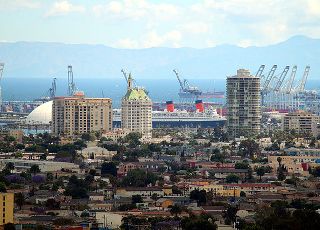 The Asia-West Coast of North America (WCNA) headhaul leg has enjoyed an extremely strong peak season, hitting in September an all-time record of 1.1 million twenty-foot-equivalent units (TEUs) for a year-on-year rise of 5.1%.
The Asia-West Coast of North America (WCNA) headhaul leg has enjoyed an extremely strong peak season, hitting in September an all-time record of 1.1 million twenty-foot-equivalent units (TEUs) for a year-on-year rise of 5.1%.
Drewry Maritime Research in its latest analysis said Asian boxes pouring into the U.S. ports surpassed the 900,000-TEU threshold for the first time ever, and the Mexican market remained strong with a rise of 17.5%. Only the Canadian trade lane remained subdued with loads scarcely any higher than a year ago. On a 12-month rolling average basis, the eastbound WCNA growth rate has steadied at 5.2% for the third consecutive month.
The peak season for the American market continued into October with Far Eastern goods bound for the States totaling again above 900,000 TEUs. The U.S. economic outlook looks brighter all the time, and plunging energy prices are providing a strong spur to consumer spending.
But Drewry cautions that it may not yet signal that “the boom times are back” for carriers, placing the surge against a backdrop of a decline in consumer spending and the ongoing port congestion on the U.S. West Coast.
It noted that the U.S. Consumer Confidence index fell several points in November from October, and that National Retail Federation data indicated sales were down 11%, or 6 million shoppers short, at the start of the Christmas spending season compared to a year earlier.
Moreover, the worsening congestion at the Los Angeles/Long Beach terminals along the U.S. West Coast has been costly for carriers on the Asia-USWC loop, as cargo is being switched to either East Coast loaders or to ships bound for Vancouver/Prince Rupert, or to air freighters.
“Contingencies to avoid lengthy days certainly caused Transpacific eastbound air freight rates to rise by 17% in October against September, although the airlines scarcely have the capacity to take any sizeable chunk of business away from the shipping lines,” noted Drewry.
The chronic congestion at the USWC ports—chiefly Los Angeles/Long Beach but Oakland, Seattle and Tacoma are also affected—has arisen due to a simmering cauldron of issues: large 10,000-TEU ships being placed in the trade, scarcity of chassis, insufficient railcar availability, not enough truck drivers, lack of any progress to conclude a new port labor agreement which has occasioned go-slows, a shortage of labor, and poor crane productivity.
The carriers have incurred huge additional costs for speeding up ships on the westbound leg, chartering in tonnage and paying labor overtime and extra quay rent. Twice in November they attempted to impose a port congestion surcharge (PCS) of US$1,000 per 40 foot and twice they were forced to capitulate, as a result of pressure from shippers, and because the Federal Maritime Commission of the U.S. challenged the legality of such a surcharge.
At the same time, the lines have allowed spot market rates to fall so sharply during the last week of November. In that week, prices dropped from $1,925 to $1,725—a fall of 10% and, despite the growth in traffic this year, spot rates have sunk to more or less where they stood a year ago. A general rate increase has been called for December 15 by the TSA, and Drewry pointed out that “coincidentally it is for the same quantum as the failed PCS of $1,000.”
“The eastbound trade has enjoyed an extremely strong peak season but this has exposed severe shortcomings in the overall supply chain network,” it said.
Photo: Regular Daddy




